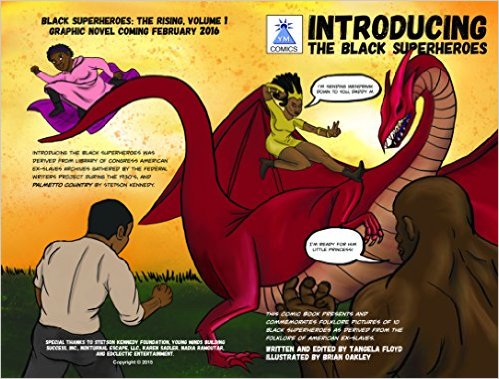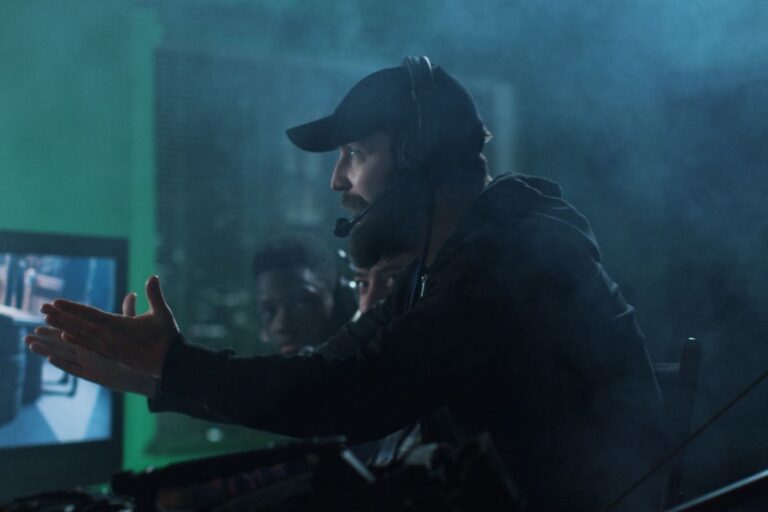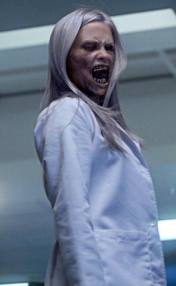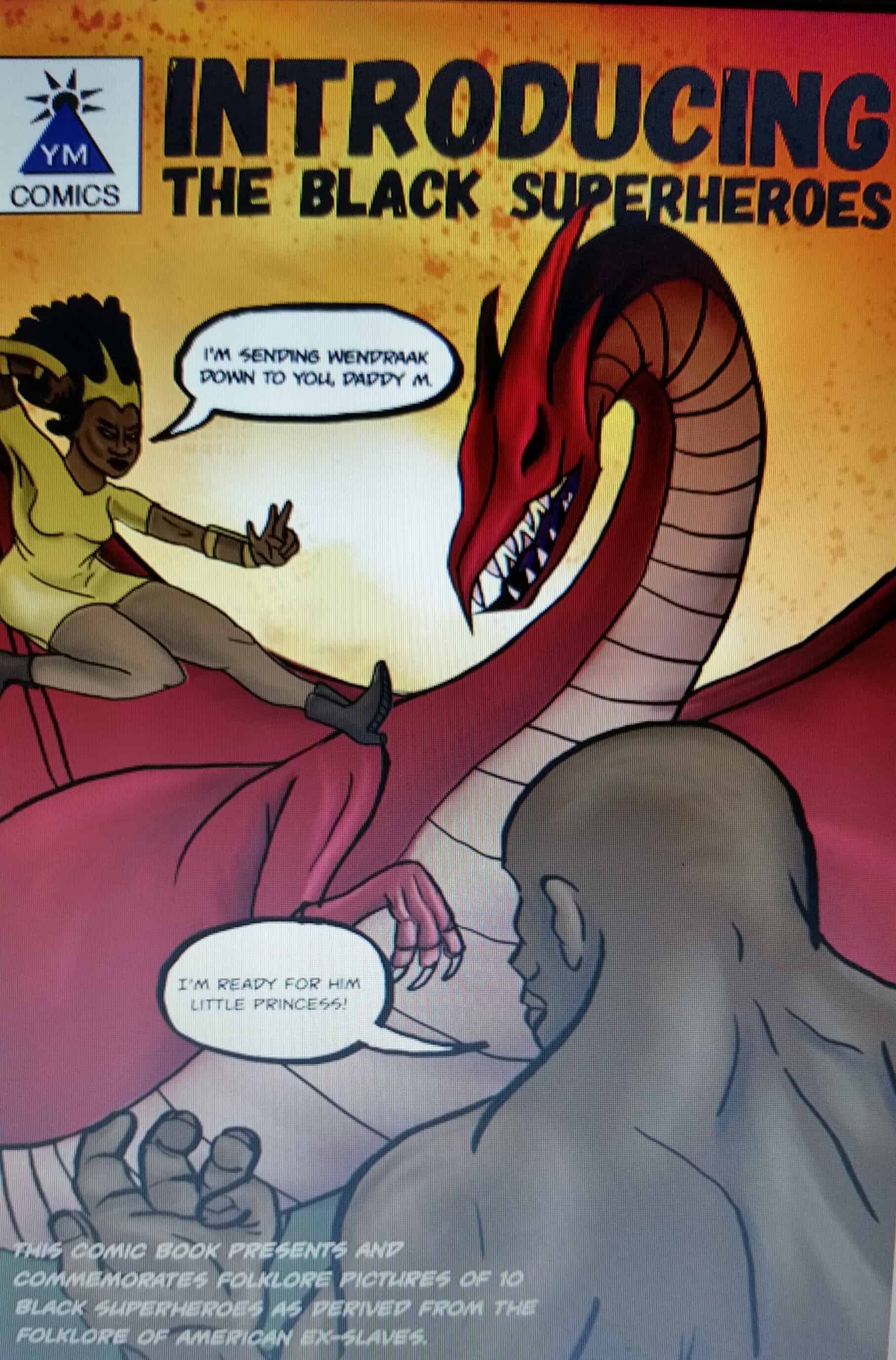 In recent years, diversity has become a hot topic in comics. Readers want more diverse characters and creators to go alongside the white, cisgendered, and heterosexual heroes of the past. Companies are slowly responding to these requests, but it could be better. Here in Jacksonville, Florida, The Black Superheroes by Tangela Floyd and Brian Oakley hopes to play a big role in diversity.
In recent years, diversity has become a hot topic in comics. Readers want more diverse characters and creators to go alongside the white, cisgendered, and heterosexual heroes of the past. Companies are slowly responding to these requests, but it could be better. Here in Jacksonville, Florida, The Black Superheroes by Tangela Floyd and Brian Oakley hopes to play a big role in diversity.
I first discovered The Black Superheroes in Superhero Hive Comics during Jax by Jax (the city’s annual writers event). Tangela Floyd, the writer, was doing a reading along with actors and was also selling copies of the preview comic Introducing the Black Superheroes. I loved the art, which combined a modern, comic look with classic folklore aesthetics to create unique characters.
Who are the Black Superheroes? Daddy Mention, super strong strategist; Uncle Monday, animal shapeshifter; Princess Kitaka, combat-ready heroine; Nine Second Men, speedster; Turpentine Sam, psychic leader; Mama Duck, skilled spy with a photographic memory; Roy and the Black Falcon, technologically savvy mechanic with a super-powered car of his own design; John the Conqueror, clairvoyant that can discover your deepest secrets; Big Mama Gertrude, carpet-flying defender of children; and Abada the Warrior, elementalist and martial arts master. Together, the Black Superheroes fight against the wicked Wendraak the dragon and the forces of oppression to make a better and stronger world.
 The Black Superheroes are actually based on heroes from African-American slave folklore, a fact that intrigued me. I set up an interview with Tangela and we met at a local café in the bustling art community of Riverside to talk about superheroes, diversity, and the positive power of fiction.
The Black Superheroes are actually based on heroes from African-American slave folklore, a fact that intrigued me. I set up an interview with Tangela and we met at a local café in the bustling art community of Riverside to talk about superheroes, diversity, and the positive power of fiction.
Pop Optiq: Hi, Tangela. How are you doing?
Tangela Floyd: I’m fine, thank you.
PO:Please, introduce yourself.
TF:Hi, I’m Tangela Floyd. I’m the executive director of Young Minds Building Success. I’m also the author of the graphic novel The Black Superheroes.
PO:Thank you. How did you come up with your idea? Black superheroes aren’t new to comics, but your approach to them is.
TF:Oh, thank you. Well, a while back, I was writing about a man named Stetson Kennedy for the Stetson Kennedy Foundation. If you don’t know who he is, Stetson was a reporter from the 1940s that infiltrated the Ku Klux Klan and exposed their illegal activities to the public. You know, things like lynching and terrorizing African Americans.
Before that, in the 1930s, Stetson was hired by the federal government to record the narratives 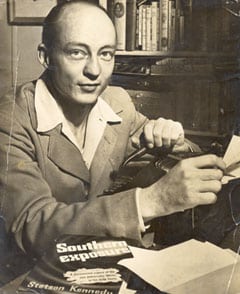 of American slaves. They were, unfortunately, dying out, so the government wanted to make sure their stories were put on record. He was assigned to the Florida Project and worked alongside Zora Neale Hurston, who was part of the Negro Unit. They recorded the slaves’ folklore and oral history.
of American slaves. They were, unfortunately, dying out, so the government wanted to make sure their stories were put on record. He was assigned to the Florida Project and worked alongside Zora Neale Hurston, who was part of the Negro Unit. They recorded the slaves’ folklore and oral history.
Before that, in the 1930s, Stetson was hired by the federal government to record the narratives of American slaves. They were, unfortunately, dying out, so the government wanted to make sure their stories were put on record. He was assigned to the Florida Project and worked alongside Zora Neale Hurston, who was part of the Negro Unit. They recorded the slaves’ folklore and oral history.
PO:That’s awesome!
TF:(Laughs) Yeah, it really is.
PO:How did Brian Oakley get involved?
 TF:Well, the Stetson Kennedy Theater does something called reader’s theater where writers and artists get to perform their work. I performed a reading of the black superhero stories, like the one you saw, and a lady named Nadia introduced me to Brian. She said he was a wonderful artist and animator. I loved his work and hired him on the spot. We’ve been working together since then and it’s gone really well.
TF:Well, the Stetson Kennedy Theater does something called reader’s theater where writers and artists get to perform their work. I performed a reading of the black superhero stories, like the one you saw, and a lady named Nadia introduced me to Brian. She said he was a wonderful artist and animator. I loved his work and hired him on the spot. We’ve been working together since then and it’s gone really well.
PO:Fantastic. The art style for The Black Superheroes is unique. Any influence from slave folklore?
TF:Absolutely. I was really specific on how I wanted the characters to look. I wanted it to be a period piece while also appealing to modern taste. Since I can’t draw, I went on the Internet and showed Brian, “Okay, I want my character to this and that. I want them to look like this” (laughs). Fortunately, Brian was able to adapt his style very well to what I wanted.
Working with Brian has been wonderful because I’m a stickler for things I like but I also like to keep an open mind for other possibilities. What’s great about Brian is that he is very patient. He listened to what I wanted and I even showed him things on the Internet. He was a very wonderful person and able to interpret all of my ideas. He has created some truly unique characters and I can’t wait for us to show them off to readers.
PO:I noticed some of the black superheroes’ abilities are common in mainstream superhero comics. Did you add those along with their original powers?
TF:There are additions. I wanted to expand the powers of the original heroes. For example, one of the characters is Roy and the Black Falcon. He is a master mechanic, but to be one, you also have to be really good with technology. So, I wrote that he is also a technology expert as well. I also wanted a character that could fly. So even though the original Mama Gertrude couldn’t fly, I felt that the quilt she carried around could be used as something she could fly on.
PO:That’s really cool how you could fuse the two together. I’ve noticed that in a lot of mythology, like the Greeks, heroes are a lot like modern superheroes.
TF:Absolutely. That’s why it’s important for the public to know that black people had that in our culture as well. It’s important because I think heroes with superpowers give people hope. It’s like we can be the masters of our situation, even if it was a fantasy at the time.
PO:I noticed that a dragon shows up a lot in the comic. Can you tell us a little about him?
TF:Yes, Wendraak the Dragon, He’ll be the main villain for The Black Superheroes.
PO:Is he part of the folklore or did you make him up?
TF:I made him up, but he’s also a symbol of oppression, of the issues back then like the KKK and Jim Crow laws. And, you know, issues with racism are still relevant. So, Wendraak will be both modern and classical that way.
PO:During the reading at Superhero Hive, you said that there was a lack of females amongst the original folklore heroes. How did you come up with the characters you included?
TF:I wanted ten characters and at least three of them had to be women. Since the original folk heroes had very few women, I added them. I’m a woman and I want my gender represented in a superhero book, so it was necessary I added them.
One of them is Princess Kitaka. She’s actually based off of Anna Kingsley. If you ever heard of the Kingsley plantation in Jacksonville, she was a slave there thought to be a Senegalese princess. I imagined her to be really strong, a fighter and conqueror.
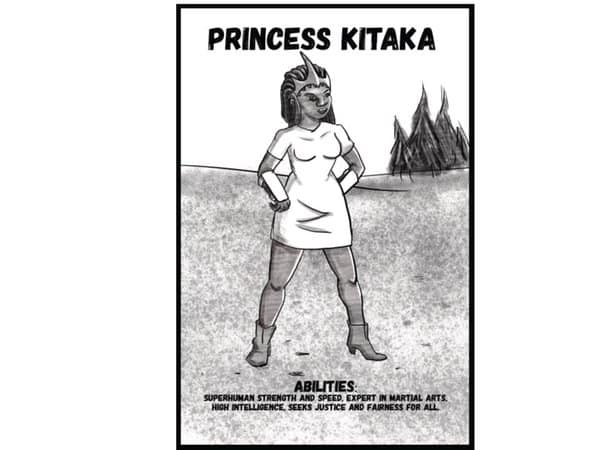 Big Mama Gertrude is also a historical figure. Throughout history, African American communities had what they called a Big Mama, someone who took care of the children while the mothers and fathers, during slavery, worked in the fields. So, in the comic, her thing is protecting children from evil.
Big Mama Gertrude is also a historical figure. Throughout history, African American communities had what they called a Big Mama, someone who took care of the children while the mothers and fathers, during slavery, worked in the fields. So, in the comic, her thing is protecting children from evil.
As for Mama Duck, she was actually one of the slaves that gave her narrative. She was called that because she talked incessantly. So, what I did was I added that she had a photographic memory. Some people with one don’t filter information well, so they talk a lot even when it’s about stuff that’s unimportant (laughs). But she’s a spy as well and she’s very good at gathering information. I think it’s pretty cool to have a superhero character with a human flaw.
PO:Wow. Sounds like you really put effort into this.
TF:(Laughs) Well, I want it to be good.
PO:Is the graphic novel going to be a series or stand-alone?
TF:I’m actually going to do two. One is going to be purely a historical novel based on the actual folklore, stuff I learned at the Library of Congress and Stetson Kennedy Foundation. I’ll stick with the historical elements so that readers will be able to learn about the folklore and see the difference between history and fiction. The second one will be fantasy because I’m a fan of that kind of story. I love Marvel and I’m a Trekkie, so I really want to write a fantasy story of my own.
PO:I saw that the preview comic was in black and white. Will it remain the same or colored?
TF:Brian and I are still debating that. The cover will be colored, but the inside will probably be B&W because it’s purposeful.
PO:It gives the comic an old school feel.
TF:Exactly. Even though I want it to appeal to a modern audience, I want it to maintain the look of the past. It just looks better.
PO:When will it be out?
TF:It was suppose to come out February 2016, but I was asked if I could move it to April for One Spark (Jacksonville’s crowd-funding event). People will be able to get it then. Also, we plan on having it on Amazon and we’ll be putting it in local comic shops.
PO:Very cool! I just realized we haven’t talked about the actual story. What’s it about?
TF:Okay, so the first one will be historical like I told you. The second book will be the superheroes, their stories, and adventures based on what slaves and black people went through in the past, and stuff that is still relevant today.
PO:Yeah, those issues haven’t gone away.
TF:No, they haven’t. Not even slavery. We have modern forms of it like with migrant workers.
PO:They’re abused by their “employers”.
TF:Exactly. They have little or no money, they’re held captive, and threatened with deportation. I want to show how that kind of issue is timely, not just stuck in the past.
PO:I think comics are a great way to discuss social issues. You see it a lot in stuff like X-Men and Watchmen.
 TF:Yes! Exactly! In fact, DC Comics did this thing where they were so inspired by Stetson Kennedy and what he accomplished, that they did a radio story called “Superman vs. the KKK.” To me, that’s just such a great thing, and it’s, just like you said, shows how comics can be very relevant to social issues. That’s what I want The Black Superheroes to be.
TF:Yes! Exactly! In fact, DC Comics did this thing where they were so inspired by Stetson Kennedy and what he accomplished, that they did a radio story called “Superman vs. the KKK.” To me, that’s just such a great thing, and it’s, just like you said, shows how comics can be very relevant to social issues. That’s what I want The Black Superheroes to be.
PO:What about the actual structure of the story? How are you telling it?
TF:I want to keep it in line with each character’s story first, and then be able to bring them all together. I don’t want to give too much away, but I’m trying to make the mix of folklore and modern consistent. I really want to make sure the women play as big a role as the men. I like to start with the strongest narratives first. Slave narrative wise, Daddy Mention’s the strongest story. Wendraak will be a common enemy to bring them together, and hopefully we can keep them together.
PO:You told me this was your first graphic novel. Have you had any prior experience in the medium?
TF: I’ve had no prior experiences writing comics. I’ve done poetry, travel writing, lecturing, and fiction. But, as I’ve said before, I love Marvel comics and the stuff they do. This will be my first time and I’m really excited to see how it turns out.
PO:Man, it sounds like you really got this figured out!
TF:(Laughs) I try.
PO:Okay, we’re almost done here. How do you feel about diversity in comics? There has been big strides for women, LGBT+, and POC characters and creators, but many say that the industry can still do a lot better. Do you think it’s getting better? Do you think it can be improved?
TF:Absolutely. Someone told me that I came into the right time because there are readers and companies that want not only diverse characters but creators as well. That made me feel excited and also that I have a responsibility to do this. My goal is to create black characters that are diverse and not stereotypical.
I feel that there is a problem with stereotypes of African Americans in media. Some of it’s  intentional, some not. However, some issues of stereotype are historical. You can’t hide it. You have to be able to discuss it. Some of it is problematic even when it seems positive, like Abada the Warrior. He is a strong character, but he also exemplifies the obsession with black male strength.
intentional, some not. However, some issues of stereotype are historical. You can’t hide it. You have to be able to discuss it. Some of it is problematic even when it seems positive, like Abada the Warrior. He is a strong character, but he also exemplifies the obsession with black male strength.
He was based on Mandingo fights where black men would fight each other while white people bet on them. You know, like from Django.
PO:Right. They were basically human dogfights.
TF:Yes. They wouldn’t fight to the death because they were property and the owners didn’t want to lose them. But it does mean that the character is problematic. So, I think the best thing to do is show that there was more to it than just the stereotype.
 For example, the real life Abada the Warrior, Tom Molineaux, was a famous Mandingo fighter. He was very intelligent as well as strong, and he found a way to make himself popular as a fighter. He got so famous that he fought a British fighter, Tom Cribb. Now, Molineaux ultimately lost the fight (although whether or not he actually lost is highly debated), but it was still important for black people to see how powerful they could be, especially since they were considered inferior. In fact, Molineaux eventually one his freedom and continued fighting professionally until 1815.
For example, the real life Abada the Warrior, Tom Molineaux, was a famous Mandingo fighter. He was very intelligent as well as strong, and he found a way to make himself popular as a fighter. He got so famous that he fought a British fighter, Tom Cribb. Now, Molineaux ultimately lost the fight (although whether or not he actually lost is highly debated), but it was still important for black people to see how powerful they could be, especially since they were considered inferior. In fact, Molineaux eventually one his freedom and continued fighting professionally until 1815.
The story of Daddy Mention is similar. He was a prisoner in a Polk County jail gifted with extraordinary strength. The jailers used him to carry logs and it became a regular sight to see him carrying one. One day, Daddy Mention picked up a log and was able to escape prison because everyone just thought he was doing his job.
In both of these stories, you have a black man trapped in a situation where his strength is abused for profit, but they are intelligent and use their powers to escape, which I think is a big theme of superhero stories. You know, using your gifts wisely for a good cause. Despite the problematic elements of their stories, they both show that there is hope.
That’s what black people focused on. That’s part of the folklore. Regardless of the situation they were in, they could free themselves one day. Even if sometimes that hope was from a fantasy standpoint, it mattered and still does. I think that’s how you can deal with problematic elements from history, show the other side to it. I think you can move beyond stereotypes by digging deeper into what makes the heroes truly powerful.
PO:Do you have any big plans for the comic?
TF: I’m excited because I want to make this a big series. Oh man, if it could make an impact like Stetson Kennedy that would mean a lot to me. I want The Black Superheroes to have a huge impact, I want it to be relevant, bring up social issues, and help us understand the past to better understand what is going on and hope for a better future. I hope kids to be inspired by our comic so that they’ll strive for one. I wouldn’t mind a Black Superheroes cartoon show, either (Laughs).
PO:Well, I’m sure Brian could do it.
TF:Yes, he could! I keep telling him that!
PO:What do you hope for in comics in the future?
TF:More African American creators and characters. More positive representations, less stereotypes.
PO:Any advice to fellow artists and writers out there?
TF:Never let anyone step on your dream. It might not be for everybody or somebody may not agree with it, or they don’t have as much enthusiasm as you do, but keep doing it. Find what appeals to you and do that. Find your own voice and let the world hear it.
PO:All right, most importance question of the day: Slash or Jimi Hendrix?
TF: Don’t make me choose!
PO:What? It’s a simple question. You just have to choose between the best guitarist of the 60s and the best guitarist of the 80s.
TF:I can’t! It goes back to my philosophy of finding your own voice. I enjoy an artist for his own unique voice. I don’t like to compare them because they’re not the same. I would rather celebrate their individuality.
PO:So, I guess you’ll go with both?
TF: Yes. Both it is.
Order the preview comic here.
Check out Tangela’s author page.
Check out Brian’s website.
